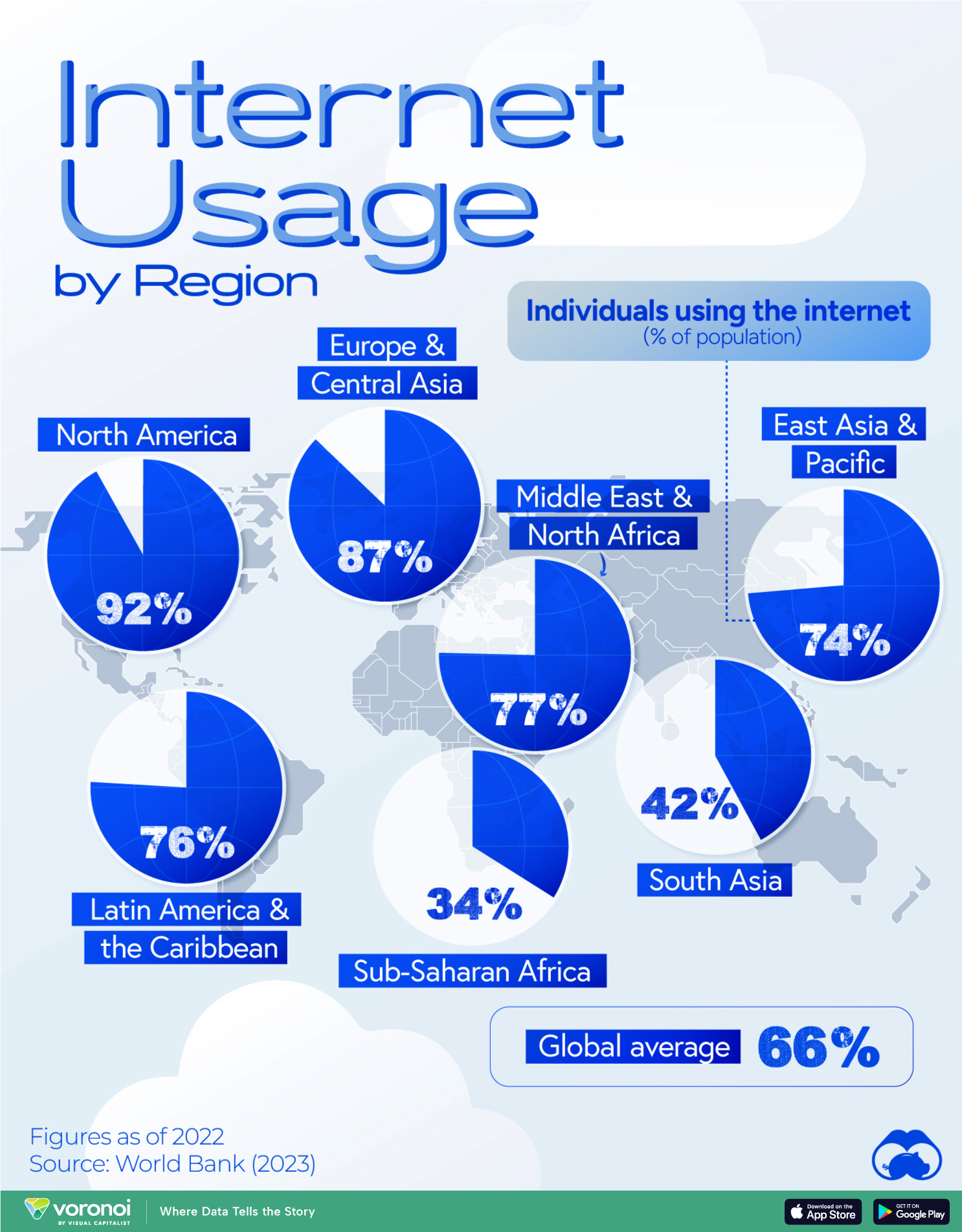Technology
Visualizing Internet Usage by Global Region
![]() See this visualization first on the Voronoi app.
See this visualization first on the Voronoi app.
Visualizing Internet Usage by Global Region
This was originally posted on our Voronoi app. Download the app for free on iOS or Android and discover incredible data-driven charts from a variety of trusted sources.
Digital technologies have become an integral part of our daily lives, transforming communications, business, health, education, and more. Yet, billions of people around the world are still offline, and digital advancement has been uneven.
Here, we map internet usage by region based on data from the World Bank’s Digital Progress and Trends Report 2023.
Digitalization Has Been Uneven
According to the World Bank, between 2018 and 2022, the world gained 1.5 billion new internet users.
In 2020 alone, the share of the global population using the internet increased by 6% (500 million people), marking the highest jump in history. India, in particular, has seen high rates of adoption. For example, in 2018, only 20% of Indians used the internet. By 2022, this percentage had grown to more than 50%.
| Region | Individuals using the internet (% of population) |
|---|---|
| East Asia & Pacific | 74 |
| Europe & Central Asia | 87 |
| Latin America & the Caribbean | 76 |
| Middle East & North Africa | 77 |
| North America | 92 |
| South Asia | 42 |
| Sub-Saharan Africa | 34 |
However, the progress of digitalization has been uneven both within and across countries.
In 2022, one-third of the global population remained offline, with parts of Asia and Africa still experiencing very low rates of internet usage. For instance, more than half of businesses in Burkina Faso, Ethiopia, Ghana, and Senegal reportedly lack internet connection.
According to the World Bank’s report, when fast internet becomes available, the probability of an individual being employed increases by up to 13%, and total employment per firm increases by up to 22%. Moreover, firm exports nearly quadruple with the availability of fast internet. Across Africa, 3G coverage has been associated with a reduction in extreme poverty, with reductions of 10% seen in Senegal and 4.3% in Nigeria.
Curious to learn more about the internet? Check out this animated chart that shows the most popular web browsers since 1994.
Technology
All of the Grants Given by the U.S. CHIPS Act
Intel, TSMC, and more have received billions in subsidies from the U.S. CHIPS Act in 2024.

All of the Grants Given by the U.S. CHIPS Act
This was originally posted on our Voronoi app. Download the app for free on iOS or Android and discover incredible data-driven charts from a variety of trusted sources.
This visualization shows which companies are receiving grants from the U.S. CHIPS Act, as of April 25, 2024. The CHIPS Act is a federal statute signed into law by President Joe Biden that authorizes $280 billion in new funding to boost domestic research and manufacturing of semiconductors.
The grant amounts visualized in this graphic are intended to accelerate the production of semiconductor fabrication plants (fabs) across the United States.
Data and Company Highlights
The figures we used to create this graphic were collected from a variety of public news sources. The Semiconductor Industry Association (SIA) also maintains a tracker for CHIPS Act recipients, though at the time of writing it does not have the latest details for Micron.
| Company | Federal Grant Amount | Anticipated Investment From Company |
|---|---|---|
| 🇺🇸 Intel | $8,500,000,000 | $100,000,000,000 |
| 🇹🇼 TSMC | $6,600,000,000 | $65,000,000,000 |
| 🇰🇷 Samsung | $6,400,000,000 | $45,000,000,000 |
| 🇺🇸 Micron | $6,100,000,000 | $50,000,000,000 |
| 🇺🇸 GlobalFoundries | $1,500,000,000 | $12,000,000,000 |
| 🇺🇸 Microchip | $162,000,000 | N/A |
| 🇬🇧 BAE Systems | $35,000,000 | N/A |
BAE Systems was not included in the graphic due to size limitations
Intel’s Massive Plans
Intel is receiving the largest share of the pie, with $8.5 billion in grants (plus an additional $11 billion in government loans). This grant accounts for 22% of the CHIPS Act’s total subsidies for chip production.
From Intel’s side, the company is expected to invest $100 billion to construct new fabs in Arizona and Ohio, while modernizing and/or expanding existing fabs in Oregon and New Mexico. Intel could also claim another $25 billion in credits through the U.S. Treasury Department’s Investment Tax Credit.
TSMC Expands its U.S. Presence
TSMC, the world’s largest semiconductor foundry company, is receiving a hefty $6.6 billion to construct a new chip plant with three fabs in Arizona. The Taiwanese chipmaker is expected to invest $65 billion into the project.
The plant’s first fab will be up and running in the first half of 2025, leveraging 4 nm (nanometer) technology. According to TrendForce, the other fabs will produce chips on more advanced 3 nm and 2 nm processes.
The Latest Grant Goes to Micron
Micron, the only U.S.-based manufacturer of memory chips, is set to receive $6.1 billion in grants to support its plans of investing $50 billion through 2030. This investment will be used to construct new fabs in Idaho and New York.
-

 Education1 week ago
Education1 week agoHow Hard Is It to Get Into an Ivy League School?
-

 Technology2 weeks ago
Technology2 weeks agoRanked: Semiconductor Companies by Industry Revenue Share
-

 Markets2 weeks ago
Markets2 weeks agoRanked: The World’s Top Flight Routes, by Revenue
-

 Demographics2 weeks ago
Demographics2 weeks agoPopulation Projections: The World’s 6 Largest Countries in 2075
-

 Markets2 weeks ago
Markets2 weeks agoThe Top 10 States by Real GDP Growth in 2023
-

 Demographics2 weeks ago
Demographics2 weeks agoThe Smallest Gender Wage Gaps in OECD Countries
-

 Economy2 weeks ago
Economy2 weeks agoWhere U.S. Inflation Hit the Hardest in March 2024
-

 Environment2 weeks ago
Environment2 weeks agoTop Countries By Forest Growth Since 2001














